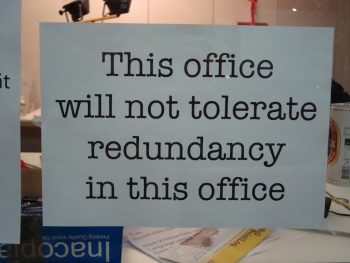Redundancy in Spanish Posted by Karoly Molina on Jul 5, 2018 in Spanish Vocabulary
Many Spanish speakers (native and non-native) are victims of redundancy. Some of these mistakes are simply because we are speaking in translation while others go much deeper in language use. Below is a list of the most common pleonasmos or redundancies/repetitions in Spanish.
Subir arriba/ bajar abajo
This is perhaps the most common pleonasmo in Spanish, and it has a very logical reason for some if not most Spanish-learners. In English, we are used to saying I am going upstairs/downstairs. This can make some of us make the mistake of saying voy a subir arriba a…. or voy a bajar abajo, but this is redundant. By saying voy a subir, people can understand this will be upstairs.
Meter adentro/sacar afuera
Just like the example above, this one is adding words that are not doing anything for the meaning. Meter already implies inside and sacar implies outside so the use of the second word is redundant. This can also be attributed to a translation from English assuming meter/sacar is the same as to put.
Persona humana
This mistake is not due to translation, but poor understanding of the words. A persona is automatically a human and vice versa. We do not have animales humanos or personas felinas, and yet many of us make this mistake. What I’ve sometimes observed is that the speaker wants to say a person was humane which is not necessarily the same as a human.
Me parece a mí que…
One of the differences between Spanish (and most Romance languages) and English is a subtle integration of the subject. Instead of saying yo te quiero, a simple te quiero already has both the subject I and object you. Something similar happens when you say me parece que. The me is already referencing the subject making a mí unnecessary.
Volver a repetir
This pleonasmo is also very common for Spanish speakers. In English, it would also be redundant to say Repeat it again because repeating already implies the again. The correct way would be to just say lo vuelvo a explicar or lo repito.
¡Oríllate a la orilla!
This pleonasmo is the most common way to mock traffic police in Mexico. There have been numerous occasions when cops have been filmed saying Oríllese a la orilla to drivers when they want to issue a fine. The verb orillarse already implies that this is done to the side.
El mas mejor
El mas mejor is perhaps my favorite of this list. In English saying the best bestest is just as silly as in Spanish saying el mas mejor. If someone is the best, you can say el mejor, and if you just want to accentuate someone’s quality in something you can say el mejor cantante, el mejor comediante, el mejor candidato, la mejor actriz, etc.
The following video covers other redundant redundancies!
Which of these pleonasmos do you accidentally use?

Build vocabulary, practice pronunciation, and more with Transparent Language Online. Available anytime, anywhere, on any device.




